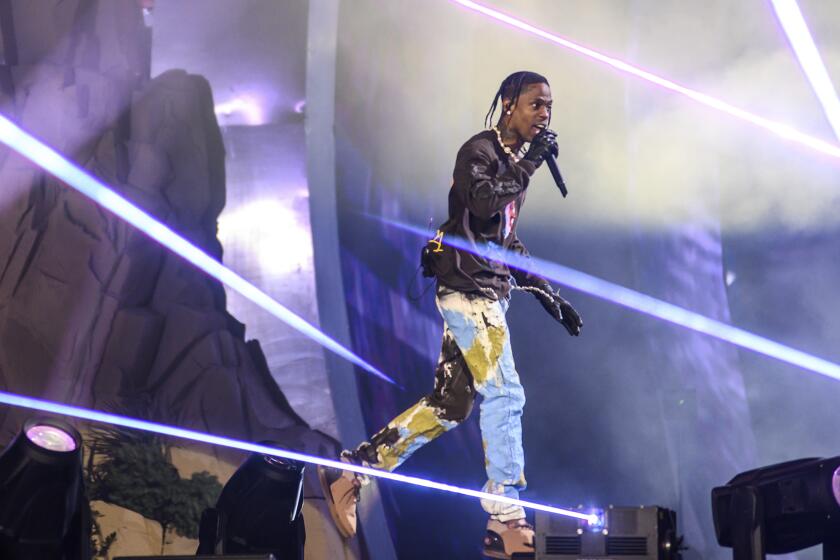Ugly truths that go unseen
Hell hath no fury like journalists protecting what they think is a righteous value, as we’ve seen with the furor over the publication of the photo of singer Rihanna’s bruised and battered face.
From the Los Angeles Times newsroom to photo desks around the country, to Howard Kurtz’s much-followed journalism chat, a consensus has emerged: Use of the photo first posted by the website TMZ amounted to a second victimization of the young star.
Kurtz called it “terrible.” The photo editor of the San Jose Mercury News told me it was “prurient” and “tabloid journalism.” A young reporter here at The Times snapped angrily at an editor that even by linking to www.tmz.com the paper had committed an act of dirty, back-door publishing.
I don’t agree. Journalists have to make a lot of tough decisions that require balancing interests and values -- in this case, the goal of protecting crime victim Rihanna from further anguish versus the goal of exposing the true nature and severity of a public crime. (R&B; star Chris Brown, 19, faces two felony counts in connection with the assault.)
It’s been argued that by posting the puffy-faced, strikingly painful image, TMZ and others embarrassed and stigmatized the pop star. I don’t underestimate how difficult this must be for a 21-year-old woman. But I think the media have paid almost no attention to another pressing threat: that domestic violence will be hidden away and suffered silently by victims, alone.
“Actually, it is not embarrassing for Rihanna. It is, however, shameful for the perpetrator,” wrote Wendy Murphy, a onetime Massachusetts prosecutor, in a column supporting publication of the photo. “And it isn’t a violation of anyone’s ‘privacy’ because crime is not a ‘private’ matter.”
Murphy, who has taught about sexual violence for 10 years at New England Law in Boston, realizes she’s from a different camp than other activists on the issue.
--
A public service
“In the ‘movement,’ they say to let the victim choose what’s public,” Murphy told me. “I try to turn this on its head and say, ‘We don’t let an eyewitness to a bank robbery or a witness in the Enron case say what the public should know.’ It’s a public concern what happens in these cases.”
I look at the Rihanna photo in the same vein
TMZ specializes in a lot of silly, raunchy celebrity piffle not worth the digits it’s recorded on. But the Rihanna photo offered a bracing dose of reality for young fans who should know that hitting, and the casual misogyny of some pop culture, can do real damage.
Establishment media outlets had a much more negative, or at best ambivalent, reaction to the picture. Part of that stemmed from a legitimate concern about verifying the source of the photo and whether it accurately reflected the singer’s injuries.
The Los Angeles Police Department hinted, though never confirmed, that it had shot the image. The department launched an investigation last month into suspicions that someone in the department leaked or sold the photo to TMZ.
An assistant police chief told The Times that the LAPD was “obligated to protect the victims of domestic violence.”
That’s essentially the stance taken by most mainstream media outlets in declining to run the picture.
Times California editor David Lauter said the paper concluded that “it was far too much of an invasion of her privacy to publish a photo of a crime victim’s battered face” when the photographer and subject had clearly not intended to have it released.
Michael Malone, director of photography at the San Jose Mercury News, said the call was an easy one and that his paper would never print such a “prurient” photo, which he said was “not something people need to see.”
--
Print versus online
But the operators of the website for the Mercury and 10 other daily papers that are part of the Bay Area Newspaper Group made the opposite determination, posting the photo with more than one story on the case.
Ari Soglin, assistant managing editor for online content of the group’s papers in the East Bay, said Web editors decided the photo would help put to rest debate about the severity of the alleged assault and would “further discussion of domestic violence.”
Soglin said the presentation of the picture -- only readers who clicked on stories about the assault would see it -- provided a type of buffer.
I’m heartened, though not surprised, to know that my media colleagues judged the merits of publishing the Rihanna picture soberly. Those who didn’t display the photo did so in good faith, hoping to protect a young superstar.
But hiding victims of domestic violence has put the onus on them for too long, leaving secret the seriousness of their abusers’ bad deeds. I would hope that even Rihanna might see that one picture -- putting a public face on private pain -- could begin to change the nature of the discussion.
--
On the Media runs Wednesday in Calendar and Friday on Page A2.
More to Read
The biggest entertainment stories
Get our big stories about Hollywood, film, television, music, arts, culture and more right in your inbox as soon as they publish.
You may occasionally receive promotional content from the Los Angeles Times.







